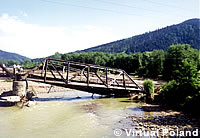European Environment Agency publishes report on sustainable water management
A European Environment Agency report published today on Sustainable water use in Europe examines ways of preventing and limiting flood and drought damage through sustainable water management. The study highlights the issue of sustainable development, which will be a central focus of the EU's Sixth Framework programme (FP6). Recent research has found that by 2050, annual rainfall will have risen in northern Europe but dropped by roughly 10 per cent elsewhere, further increasing the severity of the drought and flooding problems already experienced in the EU. The EEA report surveys the main natural and man-made causes of drought and flooding using information and experience gathered from countries across western, central and eastern Europe. It aims to help European decision-makers deal with emergency water management issues and alleviate stress on water supplies essential for human and ecosystem health. There is a high economic cost of flood damage in western and central Europe. The regions most prone to frequent flooding are geographically diverse, including the Mediterranean coast, the Rhine, Seine and Loire valleys, the dyked areas of the Netherlands, the north German coastal plains, the Alpine valleys, the Po valley in Italy, and some coastal areas of Portugal. Many of these areas form part of Europe's economic and industrial heartland, so the impact of flood damage extends beyond the loss of human life and immediate property damage. The report states that human alterations to their environment have seriously affected the risk and impact of floods. Soil and vegetation often acts as a sponge, absorbing excess water flow and preventing flooding. Man's interference with land and plant life, such as agriculture and urbanisation, can remove this safety valve and increase the risk and impact of floods. Between 1991 and 1995, the areas most prone to flooding tended to be those that have seen the greatest increase in urbanisation, such as the Mediterranean coast and the Rhine catchment. The report also highlighted the risks created by the establishment of population centres on flood plains and changes in rainfall patterns due to climate change. Europe is also becomingly increasingly vulnerable to drought, even in some of the wettest areas of the EU. Demand for water has jumped dramatically over recent decades, increasing from 100 km3/year in 1950 to 550 km3/year in 1990. The report found that while drought is a normal and recurrent feature of the European climate, occurring in both high and low rainfall areas and in any season, the problem is aggravated by several factors. The report examined the relationship between the impact of rainfall deficiency and water storage, demand and use. Agricultural changes, forest-plantation and urbanisation can all lead to drier soils and an increase in the release of ground water through vaporisation. Temperature rises brought about by climate change further aggravate the problem. The EEA suggests a two-pronged approach to tackling drought, improving both water distribution systems and water-use efficiency at user level. It also highlights unconventional water sources such as water re-use, seawater desalination and storage reservoirs to hold over water supplies from times of plenty. The report concludes that further work is needed to establish clear and consistent criteria for drought identification and technical guidance for drought situations. The EEA study also highlighted the role of socio-economic factors such as population expansion in the impact and management of large flooding and droughts. This link between scientific and social factors will be a key theme of FP6. The report was prepared by the EEA and its Topic centre on inland waters. Established by the European Union in 1990, The EEA aims to support sustainable development and help to achieve significant and measurable improvement in Europe's environment through the provision of targeted and relevant information to policy making agents and the public. The EEA's report backs up previous Commission-funded research in this area, including The (IRMA) Interreg Rhine-Meuse Activities programme of projects on flooding, set up in 1997, the Floodaware project on the prevention and forecasting of floods, and the ARIDE (Assessment of the regional impact of droughts in Europe) project, which ran from 1998 to 2000 as part of the current Framework Programme's Environment and Climate Work programme.



